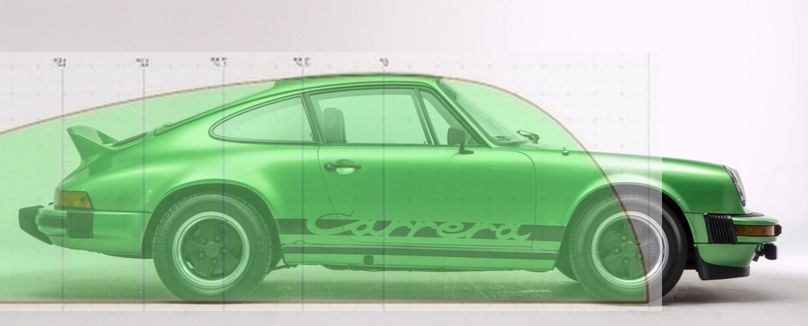I agree with what everyone else has been saying about reducing Cd and lift if you can. I'm offering this example for reference because it is so iconic and well tested.
Sourced base image below because I could not find the one out of a book Aerohead scanned into his forum gallery which shows a template overlay.
https://en.wheelsage.org/porsche/911...ctures/o3rqv5/
Then I overlaid the one of the forum's AeroTemplates from here (
not sure which page):
http://ecomodder.com/forum/showthrea...ion-21952.html
The combination:
Aerodynamics by George Kachadoorian | Photobucket

This overlay was done to provide some context for the chart quoted below, which shows a lowering of Cd and lowering of lift with ducktail.
Spoilers: front and or rear - Page 2 - Pelican Parts Technical BBS
Quote:
Originally Posted by Bill Verburg

|
Going back to one of my first comments about getting the rear spoiler to fill out the template, it looks as the Porsche 911 RS kept it just below that line for some reason unknown to myself.
Maybe your testing can examine what happens when you fill that gap in your comparative Honda Civic project. At what point does the Cd stop being lowered and starts going back up.
If your 3D printer does not allow for curved or wavy top edge of rear spoiler, then try a square notched or comb filter pattern, something like a bread knife edge.
The point would be to see if there is less drag when the vortex coming off the Gurney flap is broken down to smaller elements and is less planar or a constant cylinder of rolling air mass.
836 Gurney flaps - Aerodynamics - Civil Engineering Handbook

Quote:
Gurney first started fitting these 'spoilers' pointing upwards at the end of the rear deck of his Indy 500 cars in the late 1960s in order to enhance the generation of the downforce....................
The principle of the Gurney flap was probably exploited in aeronautics almost by accident many years before its invention. Similar strips had been in use for many years, but were intended to reduce control-surface oscillations caused by patterns of flow separation changing unpredictably. It is also likely that the split and Zap flaps, shown in Fig. 8.8b and c, that date back to the early 1930s, produced similar flow fields to the Gurney flap. Nevertheless, it is certainly fair to claim that the Gurney flap is unique as the only aerodynamic innovation made in automobile engineering that has been transferred to aeronautical engineering.
|
Concept of wavy spoiler: Distribution of energy verses concentration of energy, which may help control oscillations.
If one "feathers" the edges as found in nature (
bird feathers, whale fin tubercles) just to see what happens, there might be a nice surprise - or not.
Be brave, take a chance. Have no regrets because each failure is just another step in learning, and learning is a life long path - or at least it should be.
 EDIT:
EDIT: One more chart.
http://forums.pelicanparts.com/porsc...ront-rear.html

The 3.3 turbo tail is different than the spoiler type Ducktail, it extends out and is sometimes called a Teatray or Whaletail.
Similar to the below shown on a later model.
http://forums.pelicanparts.com/porsc...ront-rear.html

I should note that there is less drag and less lift with the type shown on the red car (tray/wing) verses the earlier green car (duck).
If you go to Bonneville you are more likely to see rear mounted horizontal extensions than near vertical ones for the same reasons. Each one attempts to fill out the Aero-template in it's own way.